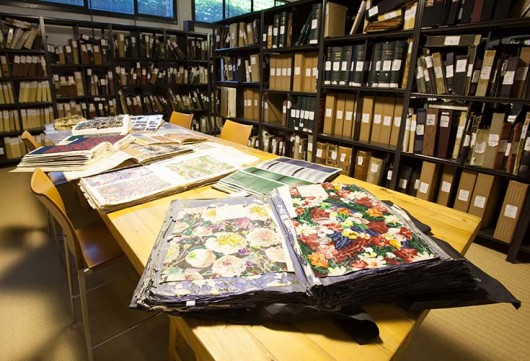BEAUTIFUL AND GOOD
L’archivio dell’azienda Canepa di Como
Kalos Kagathotos era la definizione con cui gli antichi greci riunivano in un unicum il buono e il bello, dando vita ad un’unità fra i due concetti che solo il mondo moderno avrebbe scardinato dal punto di visto estetico. Oggi, senza volere fare paradossi, una parte illuminata dell’imprenditoria della moda sta applicando questo antico concetto per realizzare prodotti ad un tempo belli e contemporaneamente buoni, sia per il consumatore, sia per l’ambiente. E siccome siamo un popolo di studi classici, la tendenza si rivela, per non dire si afferma, anche nella fruizione ed esposizione dell’arte che vediamo, ad esempio, in Fondazione Prada o nel nuovo Museo Salvatore Ferragamo. Che rispetto ad altre iniziative, si segnala con una ulteriore novità: ha ottenuto la certificazione Iso14064 in materia di sostenibilità ambientale. È il primo spazio espositivo d’arte ad emissione zero del nostro paese. Un traguardo importante che si accompagna ad una produzione di grande livello artigianale, dove un costo finale alto comporta per il consumatore il vantaggio di una qualità fuori dal tempo.
Ma anche il mondo dei filati si muove in questa direzione: quella di una produzione ecostenibile che si tramuti in un bell’oggetto (diciamocelo, molte collezioni alternative, sia pure nate con le migliori intenzioni e certamente meritorie, hanno risultati estetici modesti). Il gruppo Canepa di Como produce attuando il brevetto “save the water”, risparmiando il 90% di acqua nella fase industriale rispetto al passato. Il tutto diventa sciarpe e foulard che aiutano l’ambiente e i disastrati fiumi italiani. Belle e buone, appunto. Luisa Ciuni
Kalos kagathotos was the definition used by the ancient Greeks for something beautiful and good at the same time, a union that has been scattered, under an aesthetic point of view, in the modern era. Today, without making paradoxes, a clever part of the fashion business is applying this ancient concept to the manufacturing of both beautiful and good, for the customer and for the environment, products. And since we are a Country based on Classical Studies, this trend reveals itself even in the fruition and display of art, for example in Fondazione Prada or in the new museum Salvatore Ferragamo. That has obtained the Iso14064 certification in environmental sustainability. It’s the first art exhibition area with 0 emissions in Italy. An important goal, joined to a high artisanal manufacturing with a final high cost that means, for the customer, the advantage of a timeless quality.
But the yarn industry is moving in this direction too: a sustainable production that has a beautiful product as a result (lots of alternative collections, even if born with the best intentions, has very poor aesthetic results). The Canepa group in Como produces following the patent “save the water”, saving the 90% of water in the industrial fase, compared to the past. Then this becomes scarves and foulards that help the environment and the devastated italian rivers. Beautiful and good, indeed. Luisa Ciuni






